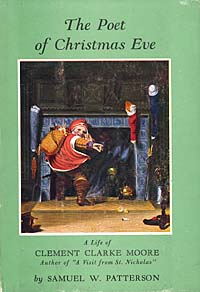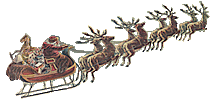CHADDS FORD -
'Tis the month before Christmas, and in the museum,
Hang pictures of Santa for visitors to see 'em.
Upon one famous poem are the pictures dependent,
Tho' a question remains about who really penned it.
Just in time for the holidays, a new exhibit at the Brandywine River Museum celebrates one of America's best-loved literary treasures:
"The Night Before Christmas."
The exhibit, on display through Jan. 8, features works of such artists as Thomas Nast, N.C. Wyeth, Everett Shinn and Jessie Wilcox Smith.
They include paintings, drawings, illustrated books and postcards from the 19th and early 20th centuries.
In the exhibit, Santa Claus is variously portrayed as a plump, pipe-smoking jolly man of imposing stature, or as a mischievous, elfin-like character.
His suit might be brown, green or red, and the toys he carries might be stuffed in a bag or a basket.
In the woodcut prints of Theodore C. Boyd, who illustrated the first book version of the famous Christmas poem in 1848, Santa is a diminutive,
debonair figure in knee breeches, buckled shoes and fur hat.
"Santa Claus at the Chimney," circa 1851-54, by Robert Walter Weir, is considered to be the earliest American painting of Santa Claus based
on the poem. The painting shows a spry, ornery gnome leaving behind an overturned footstool, a broken clay pipe, and a half-peeled orange
as he snaps his fingers and touches his nose to ascend the chimney. On his back is a basket of toys, along with a bunch of switches to
stuff in the stockings of children who have been more naughty than nice - including one unfortunate inhabitant of the home he has just visited.
He's definitely not your typical Santa Claus figure," said exhibit curator Lee Wierenga. "He's the antithesis of Santa Claus."
Weir's interpretation contrasts markedly with a 1942 watercolor by Shinn showing a cherubic, red-cheeked Santa, and with Nast's engraving
of "Merry Old Santa Claus," which appeared in the 1881 New Year's Day edition of Harper's Weekly.
"His eyes are glowing with energy and good humor," said Wierenga, who credits Nast's use of color in response to a request from a children's
book publisher with the iconic red, white-trimmed suit that remains synonymous with Santa Claus.
In Syeth's oil painting "Old Kris," the cover illustration for the 1925 Christmas issue of The Country Gentleman, Santa is bathed mysteriously
in light and shadow, looking off to the side and holding up a single index finger, as if warning a sleepy-eyed witness who suddenly appeared
in the room to keep his confidence.
The exhibit features several line drawings and brilliantly colored illustrations by W.W. Denslow, a cartoonist and designer best known for his
illustrations of L. Frank Baum's "The Wonderful Wizard of Oz."
"He can capture so much emotion with the stroke of his pen," Wierenga said. "You look at one
line and it almost vibrates off the page."
The wide variety of artistic interpretations of "The Night Before Christmas" seems only fitting, given the continuing controversy over who actually
wrote it. For more than 150 years, Clement C. Moore, a classics professor at New York City's General Theological Seminary, was credited
with writing the poem. It was first published anonymously in 1823 in the Troy (N.Y.) Sentinel. Allegedly inspired by a sleigh ride to get
a holiday turkey, Moore reportedly dashed off the poem and read it to his children on Christmas Eve 1822. A friend or relative gave the poem to
the newspaper a year later, but Moore didn't claim ownership until 1844.
"He wished that people would remember him for his scholarly works and not for what he always considered to be one of his more frivolous
attempts," said Nancy Marshall, author of a bibliography of the poem.
Moore's reluctance to claim authorship, and the fact that the poem stands in contraxt to the serious tone of his other writings are used
as evidence by those who believe the author was Maj. Henry Livingston Jr., a retired soldier and judge from Poughkeepsie, N.Y. While
Livingston never claimed to be the author, his descendants alleged he read it to his children as early as 1808.
Mary Van Deusen of Wrentham, Mass., a Livingston descendant, stumbled upon the controversy while researching her family tree and gradually came
to the conclusion that Livingston, not Moore, was the author.
"I had questions when I first started, because it just seemed preposterous," recalled Van Deusen, who acknowledges that with no extant original
manuscript from either man "no one will know with absolute certainty."
"My goal is to get everybody to make up their own mind," she said. "All they have to do is read the books of both poets and they'll come to their
own decisions."
Van Deusen enlisted the help of Don Foster, a literary sleuth who identified political writer Joe Klein as the anonymous
author of "Primary Colors," a 1992 fictionalized best seller about Bill Clinton's presidential campaign.
After studying the writing styles of both men and scrutinizing various versions of the poem, Foster concluded Livingston was the likely author.



![]() Copyright © 2014, InterMedia Enterprises
Copyright © 2014, InterMedia Enterprises